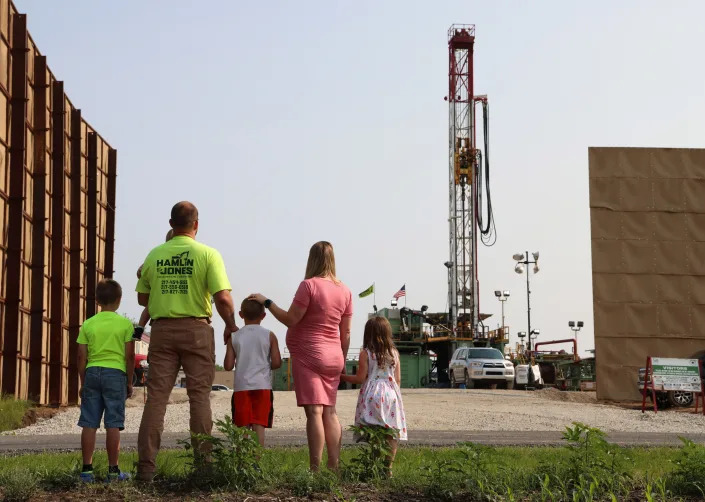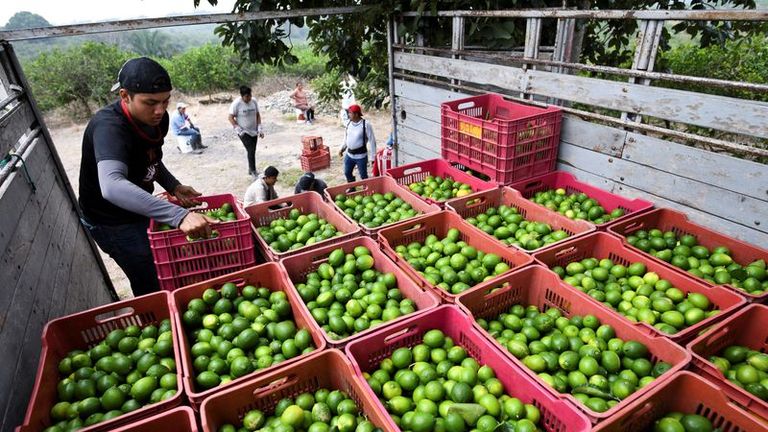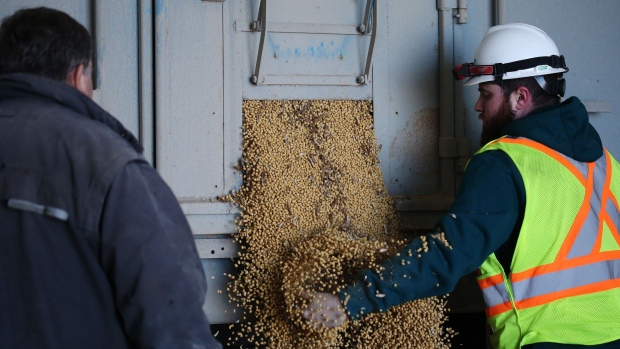


Nara Schoenberg, Chicago Tribune
Mon, July 24, 2023
One day last fall, Sabrina and Ralph Jones spotted four wooden surveyor stakes in the farm field across the street, each one marked with a strip of orange plastic.
That, the Joneses say, was their only warning that Navigator CO2 — an Omaha-based company that wants to store millions of tons of carbon dioxide underground in central Illinois — was planning to drill a testing well just 500 feet from their front door.
There was no letter from Navigator, according to the Jones, who live on a quiet country road in Nokomis, 200 miles southwest of Chicago. There was no phone call or visit. But for more than two months, starting in early May, the drilling operation filled their leafy front yard with a dull industrial hum, 24 hours a day, seven days a week.
Sabrina Jones — the mother of five young children, including a baby born in late May — said she was awakened at night by the crashes and clangs of semis dumping their loads.
When darkness fell, the drilling rig’s metal tower — about 100 feet high, with a blinking red light on top — shone strongly enough to cast shadows on the front of the Joneses’ house.
“It’s almost like a helicopter has landed in our yard,” Jones said in May.
The testing well, more than a mile deep when drilling concluded two weeks ago, comes at a time when Navigator CO2 is seeking state and federal approval for the Illinois portion of a 1,350-mile carbon dioxide pipeline that would wind through five states and store up to 15 million metric tons of CO2 a year in porous rock that lies deep beneath the ground in central Illinois.
Navigator says the project would fight climate change by preventing carbon dioxide — a planet-warming greenhouse gas captured during industrial processes — from entering the atmosphere. And the largest U.S. climate bill ever, the 2022 Inflation Reduction Act, is encouraging such projects with generous financial incentives.
But Navigator opponents, many of them landowners who don’t want to live near high-pressure pipelines carrying a potentially suffocating gas, have voiced numerous concerns, including that underground carbon storage has never before been done at this scale.
Now, Nokomis-area residents say they have yet another reason to question the project: the drilling operation outside the Joneses’ house.
“It is absolutely appalling,” said Trevor Braye, a farmer who said he could see the lights of the nighttime operation from his home, about 6 miles away.
At a time when Navigator needs to cultivate the support of landowners and public bodies, some observers say the company doesn’t appear to be doing itself any favors. Running a 24-hour industrial operation near a residence is legal in Montgomery County, where Nokomis is located, because there are no zoning laws or noise ordinances, according to county board Chair Doug Donaldson. But opponents say it’s not the best way to win over your neighbors.
Pipeline opponents also say that some families experienced serious — or complete — loss of water pressure in May, due to Navigator’s use of the local water system during drilling. And they say the company’s handling of a relatively straightforward initial project raises larger questions.
“It’s a monitoring well — one monitoring well and they’ve created chaos. And we’re expecting them to install a pipeline?” asked Karen Sanders, a community college vice president who lives in Nokomis.
Navigator declined to do a phone interview but agreed to answer questions in writing. The company said in a written statement that “safely and successfully drilling a well of this type requires 24/7 operations on the drilling site” and “the ultimate location of the well site was part of the landowner negotiations here, as it is in every lease and right-of-way negotiation.”
“Navigator takes being a good neighbor to heart and continues to work hard to minimize disruptions to neighbors and others that work or live in and around the site,” the company wrote.
A constant drone
Ralph Jones held his toddler on his hip as he gave a tour of the family’s 5-acre property, surrounded on all sides by corn and wheat fields, with no other houses in sight. There was a conveniently located climbing tree, a clubhouse for the kids and wild asparagus so sweet and tender you could eat the stalks straight from the ground.
Jones’ 8-year-old son gently scooped something up in his hand: “A toad!”
Jones’ 6-year-old son whizzed by in a go-cart, grinning and waving.
Before the drilling started, this place was so quiet that Jones, 36, co-owner of a family excavation business, and his wife, 35, a special education administrator, could lie in bed at night, hear the dog snoring outside — and be annoyed by the noise.
Sabrina Jones could tell her husband was coming home, just by the sound of his truck approaching on the two-lane country road that borders their property.
But starting in early May, the Joneses said they could hear a dull drone, which they attribute to the project’s generators, hour after hour, day after day. During a May 17 interview, the noise in the front yard hovered around 50 decibels, about the level of a quiet conversation, but at times it could get louder, the Joneses said.
“Even in our room, you can almost feel the pulses from the generator,” Sabrina Jones said.
“It’s the frequency of the sound, you just feel it in your chest a little bit,” Ralph Jones said.
They did indoor decibel readings at night, with the kids sleeping, and the noise level had risen from 40 decibels before drilling to 54-60, or approaching the level of normal conversation.
Early on, the Joneses called the police because semis were loading and unloading at 11:30 p.m., making noises as loud as pots and pans banging together.
The police explained there was nothing they could do, the Joneses said.
In response to written questions, Navigator said it conducted a sound study prior to drilling, and constructed a sound wall to reduce the average noise to “a level generally associated with normal conversations.”
The drilling rig is still across the street from the Joneses, as work to complete the well continues, according to Navigator. The company anticipates the rig will be removed in late July.
Last week, Sabrina Jones said she could still hear the droning noise.
Other local residents have complained that the drilling process, which requires water, initially caused them to lose water pressure.
Sarah Castellanos, a registered nurse who lives in the nearby city of Witt, said she and her husband woke up on a Sunday morning in May to find a semi with a water tank parked in front of their house. The driver, she said, told her husband he was from Navigator, and that EJ Water had told him to fill up his tanker at an EJ-owned hydrant in the couple’s front yard.
The truck drew water from the hydrant for about two hours, and during that time Castellanos’ neighbors, a couple in their 70s, lost their water pressure, she said.




The truck came back for more water at about 1 p.m., and shortly after that Castellanos said, her own water slowed to a trickle.
“We have to have water in the house,” she told the tanker driver. “We have a 1-year-old.”
The driver said he would slow down his water retrieval and he left — about an hour later — saying he had stopped at about 600 gallons, Castellanos recalled. She said her water remained at just a trickle until about 5:30 p.m.
“It made us feel like our rights were totally violated,” she said.
Navigator said the drilling generally required about 2,000 gallons a day, or roughly the amount of water consumed by seven area homes. Asked whether a local water company supplying Navigator pulled water from its hydrants in May to meet the demands of the drilling operation, leading to a loss of water pressure in some homes, Navigator said questions should be directed to the water company.
The water company, EJ Water Cooperative of Dieterich, did not respond to requests for comment.
‘They won’t answer questions’
This isn’t the first time that Nokomis-area landowners have objected to the way Navigator is doing business.
Navigator began trying to lease land in Montgomery County in June 2022, according to pipeline opponents.
“What’s so frustrating is no one knew they were here,” said Ralph Jones. “People are seeing these title transfers in the paper and they’re like, what is this HG Carbon Storage? What’s going on?”
HG Carbon Storage refers to the Navigator pipeline and storage project, which is officially known as Heartland Greenway.
In response to a question about the Joneses’ claim that they got no call, letter or visit from Navigator, alerting them to the plan to drill, Navigator responded that it held a meeting in January to share updates with the community.
Navigator continued: “The Joneses were some of the earliest to know about the well-site work. We outreached to local contractors in December of 2022 regarding work needed on the site, and Ralph Jones, as (co-)owner of a local excavation company, was among those that we visited with regarding the necessary dirt work for site preparation.”
Since the in-person January meeting, Navigator has held two virtual meetings, where, the Joneses say, company representatives chose the questions they would answer.
Pipeline opponents also say Navigator has refused to share its computer modeling showing how far hazardous gas might reach in the case of potential accidents — information that landowners say is important for informed decision-making.
Navigator declined to release that information saying, in part, “there are many details regarding hazard prevention that are confidential due to national security concerns.”
Eric Sanders, a farmer and the husband of the community college vice president, said that when he attended the in-person meeting held by Navigator, he asked whether there would be backup safety valves on the pipeline to shut off the flow of CO2 in the case of an emergency. And then he asked again. And again.
The answer, he said, was always a variation of “our valves won’t fail,” which he and his wife saw as typical of Navigator.
“They won’t answer questions. That’s what’s most frustrating, I think,” Karen Sanders said.
Ralph Jones was among those who objected to Navigator’s repeated reassurances that the carbon dioxide that will run in the pipelines is the same substance that makes bubbles in soda pop.
Jones noted that his pop can isn’t under the 1,300 pounds of pressure per square inch, common in CO2 pipelines.
“If it was, it would be very unsafe,” Ralph Jones said.
In a written statement, Navigator said it’s not fair to say the company doesn’t answer questions about safety directly and specifically.
“Navigator prioritizes safety, as it is one of our corporate core values,” the statement said. “Our team members are regularly addressing safety each and every day with landowners. Additionally, there is a wealth of information about pipeline and sequestration safety publicly available on our project website.”
The company said that comparing carbon dioxide and soda is a communication strategy Navigator uses to start the pipeline conversation and “help the public recognize that CO2 is something they experience in their everyday lives.”
Referring to the three informational meetings it hosted in Montgomery County in January and February, Navigator said that it had surpassed the outreach requirements outlined by the state.
“Navigator takes great pride in transparency and proactive dialogue — especially on critical topics such as project safety,” the company said in writing.
A clever strategy?
Castellanos and her husband, Tony, didn’t initially oppose the Navigator pipeline.
But after they lost water pressure in May, they went to a county board meeting to complain, posted “No Trespassing by Navigator Surveyors” signs in their yard and joined the opposition.
“We weren’t even going to get pulled into this mess, and yet here we are,” said Castellanos, 27.
Navigator doesn’t need more opposition at a time when the company faces an array of challenges, including resistance from affected landowners, many of whom have refused to sign agreements allowing Navigator to send the underground pipeline through their properties.
But while Navigator’s rift with the residents of Nokomis strikes some observers as a public relations setback for Navigator, others see a clever corporate strategy.
The highly visible testing well is a way of saying, “(There’s) nothing you can do to stop us. We’re starting to build,” said Pam Richart, co-director of the Champaign-based environmental group Eco-Justice Collaborative and lead organizer of the Coalition to Stop CO2 Pipelines.
“That’s a way of intimidating folks into thinking, ’It’s happening, I may as well sell. I may as well throw my arms up and say, ‘There’s nothing more I can do,’ ” Richart said.
Asked whether the well is intended to send an intimidating message, Navigator responded that the company needs the Nokomis testing well to determine the characteristics of underground rock and obtain the data required for federal permits allowing underground storage.
How the well will be used once data collection is completed is “uncertain at this time,” Navigator said. Testing wells can be used for CO2 injection or injection monitoring, but that requires additional permitting..
Navigator still has to get permission to build the pipeline from the Illinois Commerce Commission, where a senior gas engineer who works for the ICC recently testified that Navigator’s application should be denied until federal regulators complete new pipeline safety rules. The new rules are expected in 2024.
Navigator also needs permits from the U.S. Army Corps of Engineers and the Environmental Protection Agency.
Ralph and Sabrina Jones said they don’t believe they were intentionally targeted by Navigator, which chose the site for the testing well before the couple became active in the pipeline opposition.
Still, the Joneses noted that Navigator leased land for the testing well from an owner whose parcel included other places to drill.
Standing on his front lawn on a weekday afternoon in May, Ralph Jones peered across the street at a 40-foot sound wall covered in what looked like battered beige carpet, and the 100-foot metal tower that rose up behind it.
A dull hum filled the air as Jones reflected on Navigator’s refusal to budge on the site’s location.
“It’s almost insulting that they put it as close as they could,” he said.
nschoenberg@chicagotribune.com





